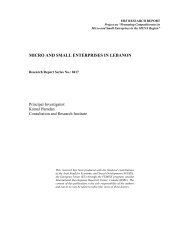The Structure and Evolution of Employment in Jordan - University of ...
The Structure and Evolution of Employment in Jordan - University of ...
The Structure and Evolution of Employment in Jordan - University of ...
Create successful ePaper yourself
Turn your PDF publications into a flip-book with our unique Google optimized e-Paper software.
contracts at all. Over time however, more than half the workers employed on temporary or nocontracts mange to obta<strong>in</strong> permanent contracts. <strong>The</strong>re appears to be very limited mobilitybetween the <strong>in</strong>formal <strong>and</strong> formal segments <strong>of</strong> the labor market, although many workers hired<strong>in</strong> formal firms are first hired <strong>in</strong>formally for a period <strong>of</strong> time. After decl<strong>in</strong><strong>in</strong>g significantlys<strong>in</strong>ce the late 1980s, government employment is now experienc<strong>in</strong>g a small recovery, but,unlike earlier times, many <strong>of</strong> the workers be<strong>in</strong>g hired by government are now com<strong>in</strong>g withsome experience <strong>in</strong> the private sector. This is a significant change from the 1980s when theopposite was true, with workers gett<strong>in</strong>g their first job <strong>in</strong> government <strong>and</strong> then, <strong>in</strong> some cases,mov<strong>in</strong>g to the private sector later. Self-employment has been a low but stable part <strong>of</strong> totalemployment <strong>in</strong> <strong>Jordan</strong>, <strong>and</strong> is mostly accessed only after a period <strong>of</strong> time as either an<strong>in</strong>formal private wage worker or an unpaid family worker.2. GDP Growth, <strong>Employment</strong> <strong>and</strong> Unemployment <strong>in</strong> <strong>Jordan</strong> <strong>in</strong> the New Millennium2.1 GDP growth, employment growth <strong>and</strong> unemployment <strong>in</strong> <strong>Jordan</strong>As shown <strong>in</strong> figure 1, GDP growth <strong>in</strong> <strong>Jordan</strong> accelerated significantly <strong>in</strong> the second half <strong>of</strong>the past decade, before slow<strong>in</strong>g significantly <strong>in</strong> 2008 <strong>and</strong> 2009 at the heels <strong>of</strong> the worldf<strong>in</strong>ancial crisis. GDP growth rates went from a healthy 4-6 percent <strong>in</strong> 2000-2003 to animpressive 8-8.5 percent per annum from 2004 to 2007. Despite this tremendous acceleration<strong>in</strong> GDP growth, unemployment rates, which were over 14 percent <strong>in</strong> the early part <strong>of</strong> thedecade, fell only slightly to over 12 percent, <strong>in</strong>creased aga<strong>in</strong> to over 14 percent <strong>in</strong> 2005 <strong>and</strong>then fell slowly to just over 12 percent at the end <strong>of</strong> the decade. This level <strong>of</strong> responsiveness<strong>of</strong> the unemployment rate to aggregate growth appears particularly weak given the veryhealthy growth rates achieved from 2004 to 2007.While the unemployment rate was particularly sluggish <strong>in</strong> its response to economic growth,the employment to population ratio, which <strong>in</strong>dicates how employment is grow<strong>in</strong>g is moreresponsive, but with a significant lag. While the acceleration <strong>in</strong> growth occurred between2003 <strong>and</strong> 2004 as shown <strong>in</strong> figure 2, the employment to population ratio rose from around 35percent to around 38.5 percent only two years later. <strong>The</strong> 2009 slowdown <strong>in</strong> growth was notyet reflected much <strong>in</strong> the employment to population ratio aga<strong>in</strong> because <strong>of</strong> this laggedresponse.<strong>The</strong> contrast<strong>in</strong>g trend <strong>in</strong> the unemployment rate <strong>and</strong> the employment to population ratiosuggests that the <strong>Jordan</strong>ian labor market seems to draw on a source <strong>of</strong> labor supply that is notcom<strong>in</strong>g from the pool <strong>of</strong> unemployed <strong>Jordan</strong>ians. This could well be foreign workers, whoare not captured very well by either the EUS or the JLMPS or from <strong>in</strong>dividuals who areoutside the labor force <strong>and</strong> who enter <strong>in</strong> periods <strong>of</strong> high labor dem<strong>and</strong>. Resolv<strong>in</strong>g this puzzleis one <strong>of</strong> the pr<strong>in</strong>ciple objectives <strong>of</strong> this paper. <strong>The</strong> hypothesis that I would like to test is thatthe composition <strong>of</strong> the workforce is <strong>in</strong>creas<strong>in</strong>gly shift<strong>in</strong>g toward higher education graduateswho are look<strong>in</strong>g for a specific k<strong>in</strong>d <strong>of</strong> job, namely pr<strong>of</strong>essional or white collar jobs, <strong>and</strong> whoare will<strong>in</strong>g to rema<strong>in</strong> unemployed for a time until they f<strong>in</strong>d such jobs. One the other h<strong>and</strong>, theeconomy seems to be generat<strong>in</strong>g lower quality jobs that do not appeal to these graduates <strong>and</strong>that are more likely to go to foreign migrants.Before mov<strong>in</strong>g to an analysis <strong>of</strong> the chang<strong>in</strong>g composition <strong>of</strong> the workforce <strong>and</strong> itsconnection to unemployment <strong>in</strong> <strong>Jordan</strong>, I exam<strong>in</strong>e more carefully the data on net employmentgrowth <strong>in</strong> <strong>Jordan</strong> <strong>in</strong> recent years <strong>and</strong> the extent to which employment growth appears to beassociated with the <strong>in</strong>flux <strong>of</strong> foreign workers. <strong>The</strong>re are three sources <strong>of</strong> data that allow us toestimate net employment growth on an economy-wide basis <strong>in</strong> <strong>Jordan</strong>, namely the<strong>Employment</strong> <strong>and</strong> Unemployment Survey (EUS), the Job Creation Survey (JCS) <strong>and</strong> the<strong>Jordan</strong> Labor Market Panel Survey <strong>of</strong> 2010 (JLMPS 2010). <strong>The</strong> EUS is the <strong>of</strong>ficial source <strong>of</strong>data on employment <strong>and</strong> unemployment <strong>in</strong> <strong>Jordan</strong> <strong>and</strong> is conducted quarterly on a sample <strong>of</strong>about 12,000 households per quarter. <strong>The</strong> JCS is a relatively new household survey, carried4

















